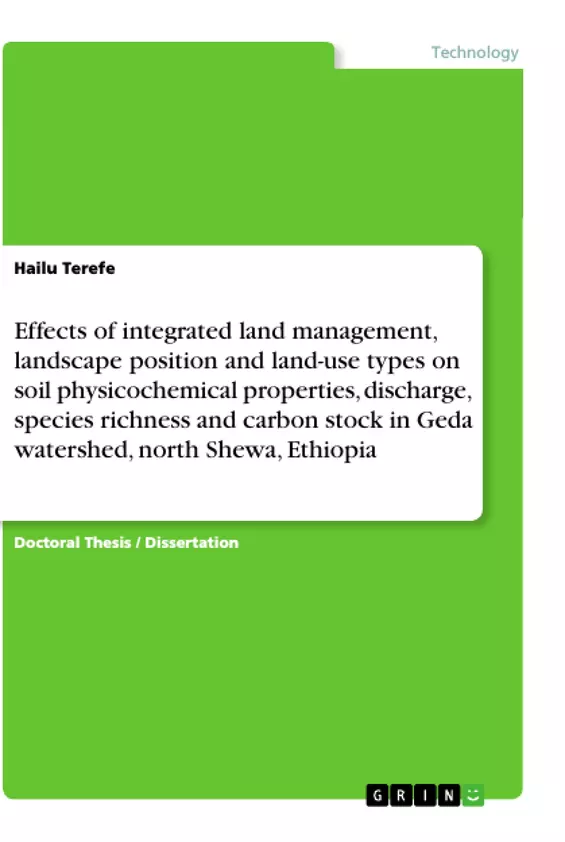This research is aimed at exploring the changes in indicators of ecosystem services associated with integrated land management practices and generating information and data from agricultural landscapes. The specific objectives are to evaluate changes in selected soil physicochemical properties of the treated site taking the neighboring control site as a base, to quantify the change in water discharge due to integrated land management practices, to assess plant species richness in the watershed and compute changes due to integrated land management practices, to determine the plant biomass production and carbon stock of the watershed associated with integrated land management practices.
This thesis is organized in five chapters. The first chapter provides general background information followed by the research problem, justification of the study, research objectives, hypotheses and research questions. The second chapter is a review of relevant literatures that gives existing evidences on the severity of land degradation, rehabilitation efforts and outcomes of rehabilitation works in Ethiopia, and the third chapter is the materials and methods section that begins with a description of the study area and explanations the research methods. Chapter four presents results and discussion of each research objective which are published in or submitted to peer-reviewed scientific journals and manuscripts under preparation. Chapter five provides the conclusions and recommendations of the research.
Inhaltsverzeichnis (Table of Contents)
- Chapter 1: Introduction
- 1.1 Background
- 1.2 Statement of the problem
- 1.3 Objectives of the study
- 1.4 Research Questions
- 1.5 Significance of the study
- 1.6 Scope of the study
- Chapter 2: Literature Review
- 2.1 Land degradation and its impacts
- 2.2 Soil physicochemical properties
- 2.3 Water discharge
- 2.4 Species richness
- 2.5 Carbon stock
- 2.6 Integrated land management
- Chapter 3: Materials and Methods
- 3.1 Study area
- 3.2 Sampling and experimental design
- 3.3 Data collection
- 3.3.1 Soil Physicochemical properties
- 3.3.2 Soil moisture content and discharge
- 3.3.3 Species richness and biomass
- 3.3.4 Carbon stock
- 3.4 Data analysis
- Chapter 4: Results and Discussion
- 4.1 Effects of integrated land management on soil physicochemical properties
- 4.2 Effects of integrated land management on water discharge
- 4.3 Effects of integrated land management on species richness and biomass production
- 4.4 Effects of integrated land management on carbon stock
- Chapter 5: Conclusion and Recommendations
Zielsetzung und Themenschwerpunkte (Objectives and Key Themes)
This study aims to investigate the impacts of integrated land management interventions on soil properties, water discharge, plant species richness, biomass production, and carbon stock in the Geda watershed, Ethiopia. The study compares treated sites with integrated land management measures to untreated control sites to assess the effectiveness of these interventions.
- The effects of integrated land management on soil physicochemical properties.
- The impact of integrated land management on water discharge.
- The influence of integrated land management on species richness and biomass production.
- The role of integrated land management in enhancing carbon stock.
- The effectiveness of different land-use types in restoring degraded landscapes.
Zusammenfassung der Kapitel (Chapter Summaries)
Chapter 1 provides a comprehensive overview of land degradation in Ethiopia, highlighting the importance of integrated land management in addressing this critical issue. The chapter introduces the study area, Geda watershed, and outlines the objectives, research questions, and significance of the study. Chapter 2 delves into the existing literature on land degradation, soil physicochemical properties, water discharge, species richness, carbon stock, and integrated land management practices. This chapter provides a theoretical framework for understanding the ecological processes at play in the Geda watershed. Chapter 3 details the materials and methods employed in the study, including the experimental design, sampling procedures, data collection techniques, and statistical analyses used to assess the effects of integrated land management. Chapter 4 presents and discusses the findings of the study, analyzing the impacts of integrated land management on soil properties, water discharge, species richness, biomass production, and carbon stock across different landscape positions and land-use types.
Schlüsselwörter (Keywords)
The key terms and focus topics of this dissertation are: integrated land management, soil physicochemical properties, water discharge, species richness, biomass, carbon stock, landscape position, land-use types, Geda watershed, Ethiopia.
- Quote paper
- Hailu Terefe (Author), 2020, Effects of integrated land management, landscape position and land-use types on soil physicochemical properties, discharge, species richness and carbon stock in Geda watershed, north Shewa, Ethiopia, Munich, GRIN Verlag, https://www.grin.com/document/986950



